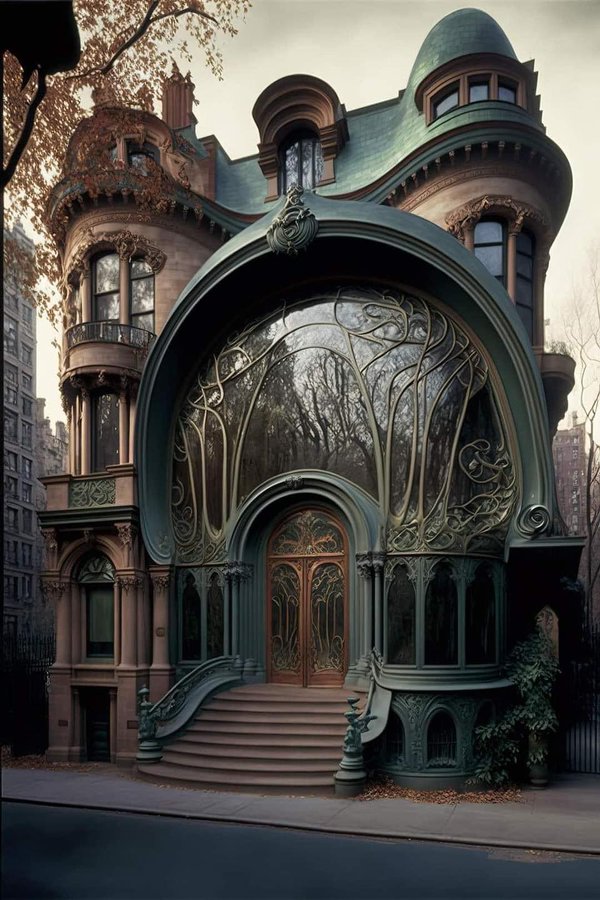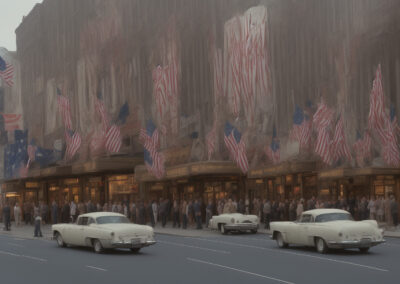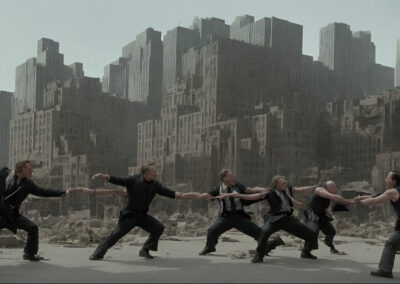Introduction
Impact of AI on Various Industries
In recent years, there seem to be few industries unaffected by the rapid advancement and proliferation of artificial intelligence (AI). What once seemed the domain of science fiction has become an everyday reality, with AI systems increasingly becoming an integral component of software, websites, industrial processes, and even the reporting of the news. AI is reshaping how we interact with technology at a fundamental level.
Potential influence of AI in Architectural Visualization
The field of architectural visualization has been influenced as well, with AI offering groundbreaking ways to interpret and render design concepts. But are these tools at the disposal of the visualization professional, or is this a fundamental shift that will replace the need for a human professional in creative professions?
Understanding AI
At the heart of AI lies machine-led intelligence, constantly evolving by drawing from an enormous pool of digital information. This offers phenomenal opportunities for creativity, as we can’t have all possible references at our immediate recall like a computer can. But where do we draw the line between AI as an innovative tool and AI in architectural visualization as a potential contender against human creativity? Or should we?
AI’s Footprint in Creative Domains
AI in daily tasks and creative industries
Artificial Intelligence certainly has its place, and it performs daily tasks we have come to rely upon. For instance, Grammarly has become a staple for many who need a helping hand with spelling or tone. And Reclaim.ai is a fantastic digital assistant for managing your schedule. Many of us have been stunned by the output of ChatGPT – both in its seeming skill and its all-too-frequent fabrications.
The Strengths and Limitations of AI in Architectural Visualization
But when it comes to visuals, is AI a friend or foe? You’re probably familiar with the picture of Pope Francis in the puffy coat, which fooled thousands of people. You also may have seen how badly these image generators can misrepresent human anatomy – especially hands. As tools like DALL-E, Midjourney, and Stable Diffusion improve, will they be able to replace those of us who model and render 3D graphics for a living?
Moral Quandaries
Ethical concerns with AI: Creativity vs Infringement?
Beyond these practical questions lie questions of propriety. When an AI program takes in the visual world and creates new images from this background knowledge, is it creating or copying? If copying, does it differ from an architect, painter, or composer who draws from what they have absorbed in their training?
Intellectual property, legalities, and AI-generated work
If AI actually can be said to infringe, who is responsible? Can you sue a non-human intelligence? Is the corporation that operates the platform responsible for everything the AI does? Or does that fall to the programmers? Should AI’s work be censored, or does it get the creative license that an artist would? Or if the work of the AI is deemed original, can the AI hold a copyright?
On the other side, a strong argument could be made that AI in architectural visualization might help to democratize design by making high-quality images more accessible. Whether it is capable of doing so remains to be seen, but it’s an interesting argument. However, if this did emerge, would it replace our jobs? Which is the greater good?
These are sorts of questions I have, but they are not questions that I will answer. I’m sure lawyers have their work cut out for them in the coming years. For my purposes, I’d like to turn our attention to how this might affect the architectural rendering professional. What can AI do? How might we effectively use it? Will it replace us?
Uses to Consider for AI in Architectural Visualization and Design
- Generative Design: AI can quickly produce numerous design iterations based on predefined parameters. This can inspire architects to venture into novel design territories. One application is to make a very crude sketch delineating the major shapes of a building and seeing what an AI image engine comes up with to fill that space. Tim Fu has explored a hybrid approach that leans on AI for inspiration but then relies on human intervention to fine-tune and make sure that they will actually work.
- 3D Modeling: AI is beginning to transform photos and sketches into 3D geometry. It is crude now, but it is becoming increasingly impressive. I have been stunned by what it has been able to create, but so far, I haven’t seen an AI-generated 3D model I would actually use in a scene. However, there were ever a point where I could say “create a 3D model of the sculpture shown in this photo and drop it in my scene”, that would be quite impressive!
- Textures: AI in architectural visualization has been used to create high-resolution custom textures which can be quite tedious. There is great potential here, but the outcome is unpredictable. Is your time better spent pulling the lever of the AI slot machine, or just getting down to work and making exactly what you need?
- Image Recognition: For visualization experts drowning in data, AI-driven image recognition is a saving grace, streamlining organization and retrieval processes. If you haven’t searched your personal Google Photos account by keyword yet, you need to give that a try. I can imagine numerous applications for using AI to sort texture maps, renderings, and inspiration images.
Specialized Applications of AI in Architectural Visualization
At J. Scott Smith Visual Designs, we’ve identified several categories of legitimate uses of AI specific to archvis that we have found particularly helpful.
Simulating Copyrighted Works
One great use-case we have found for AI in architectural visualization lies in its capability to create images that simulate movie frames to sidestep legal issues. Often, when we render a home theater or a public venue with a prominent screen, the client wants something shown on the screen. But IP (intellectual property) law is complex and unforgiving. One fantastic solution for AI in architectural visualization is to have it create an image that appears to be from a movie but is not. Avoiding legal hassles lets us and our clients rest easier. Just don’t look too closely…
Crafting Imaginary Storefront Signage
Far too often, we see renderings featuring the giant block letters: “SIGNAGE”. Developers want to identify these are storefronts and simultaneously communicate the location and size of signs. But few things shout “rendering” more loudly. One alternative would be to use the logos of real companies, but this has many issues as well. Are you sure those companies will be located there? Do you have permission to use their logo? In showing them, are you inadvertently revealing their plans or misrepresenting their plans? This concern may be avoided by using AI-generated logos. This provides fictional, yet realistic storefront signs, striking the perfect balance between authenticity and imagination.



Populating Interiors
For indoor spaces, AI in architectural visualization can produce generic but aesthetically coherent furniture, décor, artwork, and even book spines or magazine covers, thereby avoiding brand or copyright complications.
Denoising with Render Engines
Modern render engines, including Octane, have embedded AI-powered denoisers, refining visuals by removing noise while preserving details. So, rather than waiting for a clean render to resolve, the AI engine identifies noise patterns in images and replaces them with realistic noise-free versions, saving countless hours of render time.
AI Enhancements
Beyond conventional image editing, tools like Adobe Photoshop’s Generative Fill AI tool seamlessly revise images, revolutionizing content corrections and modifications. It can be used to fill in empty space or to remove unwanted features. It can even generate realistic environments, such as replacing backgrounds, changing seasons, or generating crowds – providing visualization professionals an impressive and flexible surrounding, while significantly reducing manual modeling effort.
Such tools can even be used for “image sweetening”. This can include improving textures that aren’t realistic in your rendering. It can swap out crude images of things like cars, trees, and grass and replace them with unique and believable counterparts. With some effort, this can be an effective way of incorporating people into your renderings to add scale and life without introducing distraction.
The Complex Dance of Human Expertise and AI in Architectural Vizualization
While AI presents a rich toolkit, it falls short of replicating the skills of the human designer. Experienced professionals recognize the “feel” of an image. We can understand a space and choose lighting and camera placement that reacts to the space. We can read plans, elevations, and sections and understand how they relate to one another – and where we find discrepancies we can determine the appropriate resolution. These are not things that can be automated – at least not in the foreseeable future.
The Rigorous Nature of Design & Visualization
The outsider might revel in the liberty that AI tools seem to grant, but architects and designers know a different world. AI has no bounds – but that strength is also its weakness. In the world we live in, not everything conceived of can be executed. Architects and engineers still deal with physical forces like gravity and acceptable loads. AI doesn’t consider these when making a picture from your prompt. It also knows nothing of cost-benefit analysis or site constraints. So, while AI may offer some ideas in imagining shapes at a very early design stage, it is of little use beyond that point.
But none of that matters to visualization experts. We don’t typically enjoy the same freedom that designers do. We operate within the constraints given to us. Our challenge lies in translating exacting details from provided floor plans, sketches, and material samples into accurate visual representations—a nuanced task which AI will take some time to grasp. And AI certainly can’t remember the last conversation you had with an architect client about her preferences.
And AI certainly doesn’t know what it was about that inspiration photo that the homeowner adored and what they disliked. It cannot turn the camera and show you the back of the building with all the same features, but from a different perspective. In short, AI is not human. It is amazing and it is frustrating and I’m sure AI in architectural visualization will only continue to improve, but it’s not replacing you any time soon. But that is not to say that it has no valid use today!
AI: An Enhancement, Not a Sole Player
The key, as with anything, lies in the integration of new tools and technologies into existing workflows. I remember having similar discussions about existential threats to the architectural rendering sector when SketchUp was first released. “With 3D modeling getting so easy, architects won’t need to hire us anymore!”. That was over 20 years ago. Here we are.
Then again 10 years later, there was panic over Lumion. And again, when people were elated that BIM products like Revit would do the 3D modeling for them. Certainly, these programs and others did make aspects of some modeling and rendering easier. And today, many architects use them daily. Perhaps they have no need for outside render help. That’s great! These are wonderful tools. But the rest of the world did not stand still.
Back then, most people were still using 2D clipmaps in their renderings. But today, rendering specialists use 3D assets exclusively. We have photogrammetry. We use physical cameras, textures, and lighting. We have displacement, fluid and cloth simulations, proxies and realtime GPU rendering. Atmospherics and hair are common tools. On and on I could go. Specialists will always have a larger toolset.
Power tools did not eliminate the craftsman. Cooking shows did not spell the end of fine restaurants. If anything, giving consumers a taste of what is possible – and what is required to achieve it, only serves to increase the demand for, and the appreciation of our services. There will always be people priced out of the market, or who are content to do it themselves, but there will also be those who know what it takes and want the services of an expert. And this type of client is not one who will be satisfied by a plug-and-pray AI approach to visualizing their dream home or marketing their development.
We, as specialists, would do well to stay on top of all these technologies so we are in the best possible position to oversee their use and ensure the best possible result.
Conclusion: Envisioning the Future Landscape
In my mind, our primary role is one of translator. We receive input in one language – that of plans, specs, and desires – and we translate all that information into an image that tells the whole story. We bridge the gap between professional and consumer, between designer and client. There are plenty of offshore rendering sweatshops who have been attempting this for ages. Their existence means that there are still people who they satisfy – just as gas stations still sell hot dogs and nachos.
But, based on decades of experience, I can tell you that discriminating clients are not satisfied by the bare minimum. Sure, they will deliver something, but I promise it will be a poor translation. I believe that AI is currently in a similar state. Sure, it can create stunning visuals, but will they be what was requested? Will they convey the architect’s vision? Will they even be feasible? One day, perhaps. But for the foreseeable future, I believe our jobs remain safe.
AI is a tool. And it’s one we would do well to become familiar with. But the discussion isn’t about the dominance of AI over human experts. Instead, it centers on the experience of visualization experts and their knowledge of the available tools to craft the perfect image for their clients. I look forward to watching the technology develop as a brilliant assistant rather than viewing it as an adversary.
Oh, by the way, the header image is from Stable Diffusion. I asked it to create a rendering of a house on a street. I also requested cars for scale and some people milling about so it didn’t look like it was in a desolate neighborhood.

![hdr-AI-in-architectural-renderings.jpg[1] AI in Architectural Visualization](https://jscottsmith.com/wp-content/uploads/2023/11/hdr-AI-in-architectural-renderings.jpg1_.webp)











0 Comments